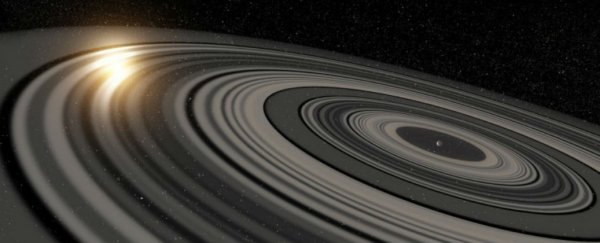Astronomers have found a planetary ring system with such enormous proportions, it makes Saturn's rings look puny. The rings have formed around a young, giant exoplanet called J1407b, and they're the first of their kind to be found outside our Solar System.
The rings were first discovered in 2012, thanks to a team led by Eric Mamajek from the University of Rochester in the US, but back then, they had no way of knowing just how big they were. They've since teamed up with researchers led by Matthew Kenworthy at Leiden Observatory in the Netherlands to analyse 30 individual J1407b rings to finally realise the true scale of these concentric beauties.
Turns out, each ring is tens of millions of kilometres in diameter, and the gaps between them suggest that whole satellites - or 'exomoons' - have formed there, just like the many tiny 'shepherd' moons of Saturn, such as Pan and Daphnis, that continue to orbit it. The diameter of the whole system is about 120 million kilometres wide.
"This planet is much larger than Jupiter or Saturn, and its ring system is roughly 200 times larger than Saturn's rings are today," said Mamajek in a university press release. "You could think of it as kind of a super Saturn."
The planet is too far away to see the rings directly, so instead, the team analysed data captured by the SuperWASP project - a survey that that detects gas giants that move in front of their parent star and dim their light - so 'eclipse' them. In 2012, Mamajek saw odd eclipses moving in front of a young star, called J1407, and suggested that perhaps they were being caused by a moon-forming disc that had formed around a young companion planet.
Now, using imaging techniques such as Doppler spectroscopy to estimate the mass of the ringed object, the Rochester and Leiden Observatory researchers have backed up this claim, saying that the star J1407 likely has a ringed companion, which they're calling J1407b.
"The details that we see in the light curve are incredible. The eclipse lasted for several weeks, but you see rapid changes on time scales of tens of minutes as a result of fine structures in the rings," says Kenworthy. "The star is much too far away to observe the rings directly, but we could make a detailed model based on the rapid brightness variations in the star light passing through the ring system. If we could replace Saturn's rings with the rings around J1407b, they would be easily visible at night and be many times larger than the full moon."
The team's paper has been accepted for publication in the Astrophysical Journal.
The researchers also found that this Super Saturn's ring system likely contains around an Earth's worth of mass in floating dust particles. "If you were to grind up the four large Galilean moons of Jupiter into dust and ice and spread out the material over their orbits in a ring around Jupiter, the ring would be so opaque to light that a distant observer that saw the ring pass in front of the sun would see a very deep, multi-day eclipse," Mamajek says. "In the case of J1407, we see the rings blocking as much as 95 percent of the light of this young Sun-like star for days, so there is a lot of material there that could then form satellites."
In the data the astronomers found at least one clean gap in the ring structure, which is more clearly defined in the new model. "One obvious explanation is that a satellite formed and carved out this gap," says Kenworthy. "The mass of the satellite could be between that of Earth and Mars. The satellite would have an orbital period of approximately two years around J1407b."
Nobody tell Saturn she's been upstaged. There's no telling what the 'crazy cat lady of the Solar System' might do, but I could take a guess, and it involves multiple cats being hurled in our general direction.
Here's a computer model that fits the light curve of the star J1407, as seen in the SuperWASP data:
